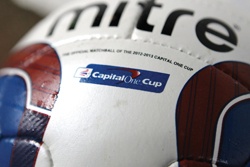Kicking off
Football is being shown the red card from fans and pundits for its on and off-pitch performance. Sponsors and clubs must offer more sophisticated engagement opportunities to score positive attention - and help the sport clean up its act.
Overpaid, overindulged and allegedly in some cases racist, football players and their teams - which stand accused of being only after fans’ cash - may have torpedoed the reputation of the beautiful game in the run-up to the Fifa World Cup in Brazil next year.
This season there have been several instances of fans in open revolt against the Premier League’s market forces, from Manchester City supporters returning tickets en masse to Arsenal in protest at the high cost of away seats, to Newcastle United fans expressing concern at the club’s new shirt sponsorship deal with payday loans company Wonga.
Newcastle City council leader Nick Forbes was among those to criticise Wonga’s £24m four-year deal, claiming it would promote “legal loan sharking” to local people facing economic hardship.
Wonga, though, says its business practices are responsible and that football sponsors promoting alcohol and gambling have not met with the same opposition. In an attempt to win over sceptical fans, after agreeing the deal last October, one of Wonga’s first acts was to rename the Newcastle stadium St James’ Park after owner Mike Ashley had controversially rebranded the ground the Sports Direct Arena the previous year.
But regardless of gripes among fans, the number of people watching the country’s most-loved sport is continuing to rise. Last season, average attendance across the Premier League was 93 per cent of capacity and figures to date suggest a similarly impressive showing this season. Viewing figures around the world are soaring too, with an estimated 4.7 billion people globally tuning in to the Premier League in 2011-2012.

Budweiser is a sponsor of the FA cup
Capital One, sponsor of last weekend’s League Cup final, shows what can happen when brands get fan engagement right. Having been quiet on the marketing front for several years, the US credit card company relaunched in the UK last year by signing a four-year sponsorship deal for the League Cup. In terms of raising both awareness and affection towards the brand, it has turned out to be a smart move.
According to research by monitoring agency Brandwatch, nearly 7 per cent of all online mentions about domestic cup football this season have featured the Capital One brand. This is significantly higher than mentions of FA Cup sponsor Budweiser, which has less than 0.1 per cent. “Although the FA Cup is talked about more, it seems sponsoring it provokes less discussion of the brand than the less prestigious League Cup,” says Brandwatch lead community manager Joel Windels.
The explanation for this could simply be that Budweiser’s sponsorship does not incorporate the same naming rights, so while the League Cup is referred to as the Capital One Cup, the beer brand only gets a name-check in the official title of the FA Cup with Budweiser, which is shortened in common reference to the FA Cup.
But there are also signs that football is a much greater driver of brand awareness for Capital One than it is for Budweiser - no doubt because it is a lesser-known brand in the UK. Brandwatch reports that 86 per cent of all mentions about Capital One come from talk about football compared with just 17 per cent for Budweiser; a demonstration of the huge effect that the sport has had in boosting Capital One’s profile.
The cup has allowed the credit card group to engage directly with a range of fans across the country, often at a grass-roots level. Through competitions, ticket offers and fans’ forums, the brand ran an intuitive social media campaign that tapped into supporters’ excitement towards the cup, helping it to increase its UK Facebook likes from 10,000 before its sponsorship to around 130,000 by the end of its first season. The brand is now planning an improved engagement strategy for next year.
Chief marketing officer Michael Woodburn says: “What I want to get better at is having all of our marketing channels pushing people to our social media hub so that they can interact further. We need to give them a reason to go there.”
Pitching to fans
Increasingly, football sponsors are waking up to the need for sophisticated fan engagement strategies, especially since the 2012 Olympics held up athletes - rather than footballers - as the new sporting ideal. Gone are the days when sponsors simply slap their name on a shirt - the rapid growth of social media and mobile usage means that brands can now use their association with clubs and tournaments to talk to fans across the world in the terms and formats they want to engage with.
That is why football tie-ups today come with promises of ‘interactive activations’ and ‘richer fan experiences’. Since Chevrolet’s reported £360m shirt sponsorship deal with Manchester United, for example, the brand has focused activity around its #DrivenBy hashtag on Twitter to capitalise on the rising popularity of live tweeting by fans during matches. HTC, meanwhile, is pledging to deliver “new and innovative ways for fans around the world to get closer to the action” as the new phone supplier of the Champions League and Europa League.
Indeed, sponsorship revenue is growing, with the combined shirt sponsorship income of all Premier League clubs up by almost 20 per cent in 2011-12 from £100.5m to £117.5m, according to Sporting Intelligence. At the same time, income-generating opportunities are expanding as clubs use new rights categories and brand touchpoints to engage sponsors in different global regions.
Although its status as the world’s biggest club distorts the picture somewhat, it is noteworthy that Manchester United has nearly 40 sponsors globally including an official wine partner (Casillero del Diablo) and an official noodles partner in Asia, Oceania and the Middle East (Mamee).
But while sponsors continue to pour cash into the global phenomenon that is English football, it is not clear that all brands are making the most of their investment. The huge amount of brand messages aimed at football supporters, combined with the rapid diversification of their media consumption, means that more sponsors are reappraising how best to engage with fans.
Cup campaigns
The sponsorship campaigns behind the FA Cup and League Cup this season provide an interesting insight into the different approaches available to brands. Budweiser’s sponsorship of the FA Cup began last season, giving it a year’s head-start on Capital One to hone its fan engagement strategies through social media and other technology.
For example, Budweiser made broadcasting history by streaming an extra preliminary FA Cup tie between Ascot United and Wembley FC live via Facebook in 2011. The move was designed to drive fan and media engagement for a match that would normally have gone unnoticed nationally, thereby increasing exposure to and interaction with the Budweiser brand.
“Traditionally, the extra preliminary round receives little interest, however this campaign was covered by international media while delivering on all key objectives of our sponsorship strategy,” says Iain Newell, UK marketing director of parent company AB InBev. “Over 30,000 international viewers tuned into watch the game online.”

Capital One’s four-year sponsorship of the League Cup encourages fan engagement
This year, Budweiser plans to use crowd-sourced assets in its FA Cup marketing by asking fans to contribute photography from any match in the tournament for inclusion in a two-minute advert that will air in the last break before the final on 11 May, as well as on the big screens and perimeter boards at Wembley.
The initiative will run via Twitter and Instagram, with fans uploading photos and tagging them to Budweiser’s #tothedream hashtag. Newell says one of Budweiser’s core concerns is to “bring the cup closer to fans through a strategy that celebrates grass-roots football and showcases the tournament on a global level”.
The brand’s other football-related innovations include the Budweiser Man of the Match app that allows fans to pick the outstanding player from any FA Cup match (a role traditionally performed by TV punditry teams) and a partnership with augmented reality platform Aurasma, where fans can point their smartphone or tablet device at limited edition Budweiser beer cans to see the FA Cup appear in 3D.
Similarly, Capital One has used social media to interact with fans interested in the League Cup, though Woodburn says the brand’s first year as title sponsor has been a learning experience in which it has paid close attention to the online chatter generated by supporters. “People have started coming to our [Facebook] page to talk about the football matches, which is great,” he says. “We just want to be part of that conversation for now rather than pushing brand messages at people.”
The brand has upped its activity on social media during popular matches, such as Arsenal’s dramatic 7-5 victory over Reading in October and Bradford City’s giant-killing run to the final. By listening to fans online, Capital One has also succeeded in identifying a number of PR opportunities that have served to increase goodwill towards the brand.
For example, the company paid for Middlesbrough fans to travel to Swansea last December for their cup match because the team had been drawn away from home 12 consecutive times in the tournament. “It’s that type of engagement that really resonates with fans and it’s something we’ll look to build on during our second season,” comments Woodburn.
Football crowd-sourcing
The ability of sponsors to grow their following through fan engagement is a cause for optimism among the football clubs, many of whom wish to build their own brands as a way of increasing revenues. The Football League is aiming to help its 72 member clubs better understand their fans with its new Changing Room research panel. Launched last month, the initiative encourages fans to participate through postings on all the club websites, right down to the small provincial sides in League Two. The Football League plans to recruit 15,000 fans to the panel, with each club represented (see Q&A).[1]
In addition to engaging members with football content, forums and rewards, the Changing Room will conduct targeted surveys that aim to provide clubs and sponsors with deeper insights into fans’ behaviour. Football League research and insight executive Phil McKee reveals that the Changing Room could also form a testing ground for sponsors, allowing brands to trial the creative in their football-related marketing campaigns before rolling them out.
“The beauty of it is we can survey everyone in the group or we can do more targeted research,” he says. “For example, if Exeter City wanted to ask their fans something quickly, we can just ringfence those people, or if a brand wanted to speak to a certain demographic, we could do that. If we know more about our supporters, we can tailor to their needs better.”

Sunderland FC works closely with communities through its Foundation of Light charity set up in 2001
Beyond the online world, clubs are also engaging with fans through new technology at their stadia. Derby County has been one of the most innovative clubs in the Football League this season, having undertaken a major upgrade of technology at its Pride Park stadium while also rolling out a new demand-based pricing system for its match tickets (see case study).
Last summer, Derby bought new hardware for the stadium, including LED perimeter advertising, a 77 sq m screen - one of the largest in club football, digital menu boards for the concourses and an improved internal camera system. Although this technology has given Derby greater flexibility in the advertising solutions it can offer to brands and sponsors, it has also increased the club’s ability to engage directly with its supporters on match day.
For example, the upgraded camera system can zoom in on fans in the ground for various engagement segments, with the jumbo screen serving as a giant ‘fan cam’. The club also opens the stadium doors early on match days, allowing fans to watch televised lunchtime matches on the big screen prior to kick-off or exclusive content produced by the club.
Marketing manager Faye Nixon says these engagement efforts are designed to offer fans and their families a day out rather than just a football match. She claims this approach is already bearing fruit this season, with more fans arriving earlier to the stadium and spending more on refreshments.
“Everybody in the leisure industry is vying for people’s disposable income so we’ve got to make it more than just an hour and a half of football, we’ve got to make it an entertainment experience as well,” she says. “That includes the pre-game, half-time and post-game experience.”
Community engagement
Football clubs provide a focal point for communities across the UK, so fan engagement often also means working closely with those communities to improve people’s lives. Sunderland Football Club achieves this through the Foundation of Light, a charity set up in 2001 by former chairman Sir Bob Murray that has become central to the club’s identity.
Sunderland says the foundation is the largest in European football, with 120 staff that help more than 40,000 children in the region. The foundation’s size means that Sunderland can go beyond the grass-roots football work that other clubs might focus on to tackle deep-rooted social problems as well.
For example, the foundation runs educational programmes from specially designed classrooms within Sunderland’s home ground, the Stadium of Light, for children that have a history of troubled behaviour at school.
In addition to support from the club, the foundation is backed by major local employers such as machinery manufacturer Caterpillar.
Sunderland marketing director Mike Farnan says the foundation has played a pivotal role in forging a close-knit community with the club at its heart. This sense of community translates into strong support for the club: last season, Sunderland had the seventh highest home attendance in the Premier League.
“With 44,000 children and 120 employees, you’re talking about a lot of people depending on it,” says Farnan. “It’s something unique and different, simply because the region needs it. I think the club has been very sensitive to that requirement.”
While the foundation is a philanthropic rather than a commercial operation, its work has attracted the interest of sponsors keen to harness its community ethos. In particular, the foundation was an important element in Sunderland’s shirt sponsorship agreement with Invest in Africa last summer.
The deal, reportedly the most lucrative sponsorship in Sunderland’s history, arose after Tullow Oil founder Aidan Heavey read about the Foundation of Light and believed he could adapt some of its work to Invest in Africa, his not-for-profit development agency on the continent.
Sunderland is now pursuing its own charitable initiatives in Africa through the sponsorship, although the deal has also presented the club with a huge range of sporting and commercial opportunities. This includes forming partnerships with African clubs that are helping Sunderland to build up its fanbase on the continent and forge more brand tie-ups. Farnan says it is likely that “an African consumer-facing brand” will appear on Sunderland’s shirts next season as part of the Invest in Africa deal.
“Sunderland isn’t a Man United or a Liverpool but by aligning itself with this programme it’s galvanised itself in Africa,” says Farnan. “If you look at the interest we’re getting in Africa, right across from federations, football clubs and commerce, it’s just been unbelievable.”
Sunderland is a good example of the popularity of English football globally when clubs get fan engagement right. As more brands look to harness the power of the sport around the world - and football itself works to clean up its image - they must pay attention to how supporters watch and interact with their favourite clubs and tailor their engagement strategies accordingly.
References
- ^ (see Q&A). (www.marketingweek.co.uk)









